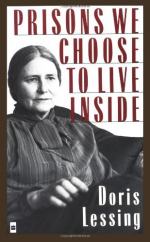
|
| Name: _________________________ | Period: ___________________ |
This test consists of 15 multiple choice questions and 5 short answer questions.
Multiple Choice Questions
1. According to Lessing, what word gets people excited to fight?
(a) "Blood."
(b) "Justice."
(c) "Violence."
(d) "Hatred."
2. How did the whites feel about the blacks in Rhodesia?
(a) Vindictive.
(b) Prejudiced.
(c) Benevolent.
(d) Protective.
3. When did the miner's strike referenced by Lessing take place?
(a) 1930s.
(b) 1920s.
(c) 1800s.
(d) 1980s.
4. When did the political group Lessing belonged to in Rhodesia fall apart?
(a) After the war.
(b) When she betrayed it.
(c) During the war.
(d) In the 1980's.
5. Lessing believed people could grow if they only detached from ___________.
(a) Their family.
(b) Mass emotion.
(c) Lessons from the past.
(d) The idea of love.
6. The tree was cut down for its association with _____________.
(a) A dictator.
(b) A foreign Colonel.
(c) Religion.
(d) A traitor.
7. How long did the regime in Rhodesia last?
(a) 50 years.
(b) 90 years.
(c) 1 year.
(d) 20 years.
8. How old is the Arthasastra?
(a) 10,000 years.
(b) 2,000 years.
(c) 100 years.
(d) 50 years.
9. During a riot in Brussels, what shocking act did humans perform on corpses?
(a) Grave robbing.
(b) Urination.
(c) Disrespect.
(d) Graffiti.
10. What does Lessing hope will one day change human behavior?
(a) Awareness.
(b) Scientific data.
(c) All of these.
(d) Learning from our past.
11. What did the farmer do to punish the bull for its kill?
(a) Killed it.
(b) Sold it.
(c) Whipped it.
(d) Bred it.
12. According to Lessing, what is a recipe for social disorder?
(a) Individuals with big ideas.
(b) Leaders with control issues.
(c) A lack of money in society.
(d) Subgroups with differing opinions.
13. What surprised Lessing regarding human behavior over time?
(a) How much it had changed.
(b) How little it had changed.
(c) The intelligence amassed.
(d) The faith that has grown.
14. What was an unquestionable belief held by the political party Lessing joined in Rhodesia?
(a) Religion was obsolete.
(b) None of these.
(c) Communism was dead.
(d) Blacks were superior.
15. Lessing believed the human race to be in _________.
(a) "An inspirational transformation."
(b) "Purgatory."
(c) "An expected state."
(d) "A terrible mess."
Short Answer Questions
1. Lessing referred to the sciences regarding human behavior as what type of science?
2. What was the label put on anyone in Rhodesia who disagreed with the ruling class?
3. Lessing believed that a belief pattern of "you-are-damned, I-am-saved" in society is ________.
4. Who was surprised by what happened to the miner who returned to work during the miner's strike?
5. The political group Lessing joined in Rhodesia held what hope for the world under their rule?
|
This section contains 396 words (approx. 2 pages at 300 words per page) |

|




